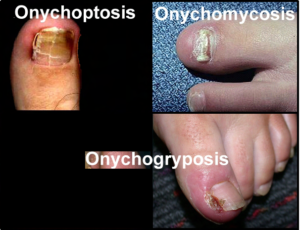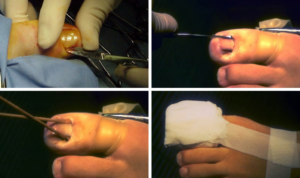a. General Considerations. The removal of a toenail is a simple and safe procedure. This procedure requires a minimum of skill.
b. Indications for Toenail Removal. A toenail may need to be removed in any of the circumstances given below. See figure 1-4.
(1) Ingrown nail (ohychoptosis).
(2) Ringworm or fungus infection of the nail (onychomycosis).
(3) Inflammation of the nail fold (chronic or recurrent paronychia).
(4) Deformed, enlarged, curved nail (onychogryposis).

Substitute Figure 1-4
c. Definitive Treatment. Removal of the toenail is definitive treatment for bothersome, chronic ingrown toenails that do not respond to the following conservative measures.
(1) Change of footwear to minimize compression of toes.
(2) Frequent soaking and elevation of the affected toe.
(3) Patient education regarding proper trimming of toenails.
(4) Elevation of the affected ingrown nail edge with a cotton wick.
d. Contraindications for Removal of the Toenail.
(1) The toenail should not be unnecessarily removed if the patient has:
(a) Diabetes mellitus.
(b) Peripheral vascular disease.
(c) Bleeding disorders.
(d) Allergy to local anesthetics (relative contraindication).
(2) Presence of soft-tissue infection or paronychia may be a relative contraindication. It is recommended that the infection be treated prior to removing the toenail.
e. Equipment. Gather the following equipment.
(1) A 3 or 5 ml syringe.
(2) 2 percent lidocaine without epinephrine.
(3) Sterile scissors with straight blades (or narrow periosteal elevator).
(4) A sterile rubber band.
(5) Two sterile straight hemostats.
(6) Phenol solution (88 percent) for permanent removal of the nail.
(7) Isopropyl alcohol swabs.
(8) Sterile cotton swabs.
(9) Antibacterial or antibiotic ointment (for example, Betadine®, Bacitracin®).
(10) Sterile gauze pads (4 x 4).
f. Procedure. Use the following procedure for removal of the toenail.
(1) With the patient supine, scrub and drape the toe in a sterile fashion.
(2) Administer local anesthetic in ring-block fashion as described below.
(a) The total solution should be 5 ml.
(b) Raise a wheal at the base of the toe on the extensor surface on the affected side.
(c) Direct the injection toward the plantar surface to envelop both the extension and plantar branches of true digital nerve on that side.
(d) Deposit 1 ml at each site.
(e) Retract the needle slightly.
(f) Redirect the needle horizontally across the dorsal surface of the toe.
(g) Inject 0.5 ml under the skin at the base of the toe on the opposite side.
(h) Perform a second puncture at that site.
(i) Advance the needle in the plantar direction.
(j) Deliver 1 ml of anesthetic to each branch of the digital nerve.
(3) When the anesthesia is achieved, secure a sterile rubber band with a straight hemostat to serve as a tourniquet.
(4) Remove the nail from the nail bed using the following procedure (see figure 1-5).
(a) Using a flat pointed blade of scissor, straight hemostat, or narrow periosteal elevator, introduce and advance the instrument upward and against the nail and away from the nail bed. This minimizes injury and bleeding.
(b) Completely free the nail at its base under the edge of the cuticle. This allows the nail to be completely removed and provides exposure to the germinal tissue of the nail bed.
(c) Using scissors, completely split the nail in a longitudinal direction. The split should include the base of the nail that rests against the cuticle.
(d) Using a straight hemostat, grasp the portion of the nail to be removed lengthwise.
(e) Remove the nail using a steady pulling motion with a simultaneous upward twist of the hand toward the affected side.
(f) In case of recurring problems with the regrowing toenail, it is recommended that the germinal tissue of the toenail be removed permanently. Follow this procedure.
1 Sponge the exposed nail bed dry with cotton swabs.
2 Cauterize the area by applying phenol to the nail bed tissue.
CAUTION: Avoid allowing phenol to come into contact with normal, healthy skin.
3 Hold a phenol-dampened swab in place for three minutes.
4 Swab the area with an isopropyl alcohol swab to neutralize the phenol.
(5) Apply antibacterial or antibiotic ointment to the nail bed.
(6) Cover the area with a sterile gauze pressure dressing.
(7) Remove the tourniquet.

g. Follow up Care. Advise the patient to rest his foot during the first 24 hours after surgery and to elevate his foot when possible. Tell him to return in 24 hours for a dressing change. The procedure for the dressing change is given below.
(1) Re-apply antibacterial ointment.
(2) Apply a less bulky dressing.
(3) Encourage ambulation and a return to normal activity within the next two days.
(4) Tell the patient to soak his toe in warm water after the next 48 hours. The soak should be in warm water for 20 minutes two times a day.
(5) Inform the patient that he should expect exudate from the toe. The exudate may last as long as three weeks.
(6) Schedule a follow-up visit for one month later to assess the healing process.
